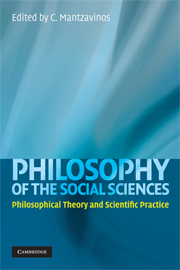Book contents
- Frontmatter
- Contents
- List of Contributors
- Acknowledgements
- Introduction
- Part I Basic Problems of Sociality
- Part II Laws and Explanation in the Social Sciences
- Part III How Philosophy and the Social Sciences Can Enrich Each Other: Three Examples
- 8 Why Do People Cooperate as Much as They Do?
- Comment
- 9 Situations Against Virtues: The Situationist Attack on Virtue Theory
- Comment
- 10 What Kind of Problem is the Hermeneutic Circle?
- Comment
- Epilogue
- Name Index
- Subject Index
- References
10 - What Kind of Problem is the Hermeneutic Circle?
The Situationist Attack on Virtue Theory
Published online by Cambridge University Press: 05 June 2012
- Frontmatter
- Contents
- List of Contributors
- Acknowledgements
- Introduction
- Part I Basic Problems of Sociality
- Part II Laws and Explanation in the Social Sciences
- Part III How Philosophy and the Social Sciences Can Enrich Each Other: Three Examples
- 8 Why Do People Cooperate as Much as They Do?
- Comment
- 9 Situations Against Virtues: The Situationist Attack on Virtue Theory
- Comment
- 10 What Kind of Problem is the Hermeneutic Circle?
- Comment
- Epilogue
- Name Index
- Subject Index
- References
Summary
The hermeneutic circle serves as a standard argument for all those who raise a claim to the autonomy of the human sciences. The proponents of an alternative methodology for the human sciences present the hermeneutic circle either as an ontological problem or as a specific methodological problem in the social sciences and the humanities. One of the most influential defenders of interpretivism in the English-speaking world, Charles Taylor, contends for example (1985: 18):
This is one way of trying to express what has been called the “hermeneutical circle.” What we are trying to establish is a certain reading of text or expressions, and what we appeal to as our grounds for this reading can only be other readings. The circle can also be put in terms of part-whole relations: we are trying to establish a reading for the whole text, and for this we appeal to readings of its partial expressions; and yet because we are dealing with meaning, with making sense, where expressions only make sense or not in relation to others, the readings of partial expressions depend on those of others, and ultimately of the whole.
Our understanding of a society is supposed to be circular in an analogous way: we can only understand, for example, some part of a political process only if we have some understanding of the whole, but we can only understand the whole, if we have already understood the part. In this chapter I would like to check the soundness of this argument.
- Type
- Chapter
- Information
- Philosophy of the Social SciencesPhilosophical Theory and Scientific Practice, pp. 299 - 311Publisher: Cambridge University PressPrint publication year: 2009
References
- 1
- Cited by



